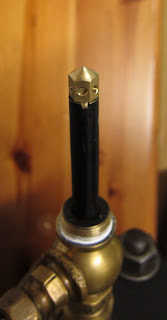 |
| At 83, young Joyce playing in the snow on Boxing Day 2010 (I must make some Xmas cards with this photo for next year) |
I've also found that visitors to Midsomer Norton Station are starting to ask me more informed and searching questions lately (who's leaking the information, I wonder?). I even get a few 'blog comments, some sensible, some humorous. I'll leave you to figure out which fall into which category!
There is probably not much more to blog in 2011 but you never know. The weather has decided to cool it emphatically and contact with cold metal drains body heat in no time through gloves, footwear and clothing; not a pleasant experience.
The arrival of the DMU at Midsomer Norton has left Joyce isolated in the platform opposite the maintenance facilities of the goods' shed. Much anticipated activity has had to take a back seat and, after three weeks, I'm still waiting to turn the engines on compressed air to splash the gloppy crankcase oil about in the lower gear cases. Hopefully, when Santa has been and gone, normality will return and more progress can be made.
2012 should see Sentinel 7109 in steam again for the first time since the 1960s. There's still a long way to go but most of the major subsystems' restoration has been sorted and, when circumstances allow, it will be more a matter of bolting all the bits together and lighting the fire than the endless grinding away at rust and debris ("How naive", did I hear someone say!).
Have a good break and hope to see some of you as visitors to Midsomer Norton Station in the new year.
PS If you find yourself bored over the break whilst waiting for the next posting, why not have a look at Douglas Self's 'Unusual Locomotives' web page. It's rather short on UK Sentinels at the moment, however, hopefully that won't always be the case!






















































